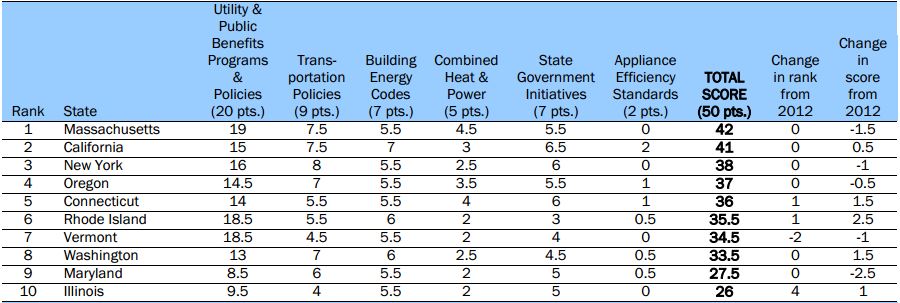In early November 2013, the American Council for an Energy-Efficient Economy (ACEEE) released its annual report ranking all U.S. states by their efforts to improve energy efficiency policies and programs. The report, titled “The 2013 State Energy Efficiency Scorecard,” serves as a benchmark for state energy efficiency activities and encourages states to continue increasing their efforts and commitments.
ACEEE’s Scorecard is set on a 50 point scale, which is broken up into six main policy areas – utility and public benefits programs, transportation policies, building energy codes, combined heat and power (CHP) policies, state government-led initiatives, and appliance and equipment efficiency standards. These policy areas are assigned different point weightings to reflect the magnitude of energy savings possible through that policy area. For example, the energy savings potential from utility and public benefits programs is much higher than that of CHP policies or state government-led initiatives and is, therefore, assigned 20 possible points compared to five and seven possible points, respectively.
Results from the 2013 ACEEE Scorecard reveal greater efficiency efforts in Northeast and Pacific West states and lower efficiency efforts in Midwest and Southeast states. In total, the U.S. experienced substantial energy savings through both electric and natural gas efficiency programs (22.9 million MWh and 232.3 million therms, respectively). Compared to last year’s report, 17 states received higher scores, while 29 states received lower scores. This is due to changes and updates in scoring methodology, which has ‘raised the bar’ from last year’s benchmarks. Building energy codes showed the most improvement in scores, while utility and public benefits programs saw the biggest drop.
Massachusetts ranked first in energy efficiency for the third year in a row, surpassing California in 2011. Compared to all other states, Massachusetts received the highest score in utility and public benefits programs, earning 19 out of a possible 20 points. The state’s high overall score reflects is efficiency efforts that have been supported by the establishment of the Green Communities Act in 2008 and ambitious targets for its Energy Efficiency Resource Standards (EERS) in the coming years. California, which ranked second on ACEEE’s scorecard this year, earned high marks in building energy codes as well as appliance and equipment efficiency standards, partially due to the state’s stringent Title 24 Building Standard. The majority of high ranking states in this year’s report have consistently been in the top tier, indicating their sustained, long-term commitments to energy efficiency policy and programs.
The report concludes with strategies for further improving state energy efficiency efforts. First, it recommends establishing an EERS or similar energy savings target in all states. Standards for building efficiency and transportation emissions should become more stringent over time, as both these sectors contribute significantly to total U.S. energy consumption. CHP ought to be treated as an energy efficiency resource and made eligible within EERS or renewable portfolio standards. Lastly, ACEEE suggests expanding state-led efforts, such as ‘lead by example’ public programs.

